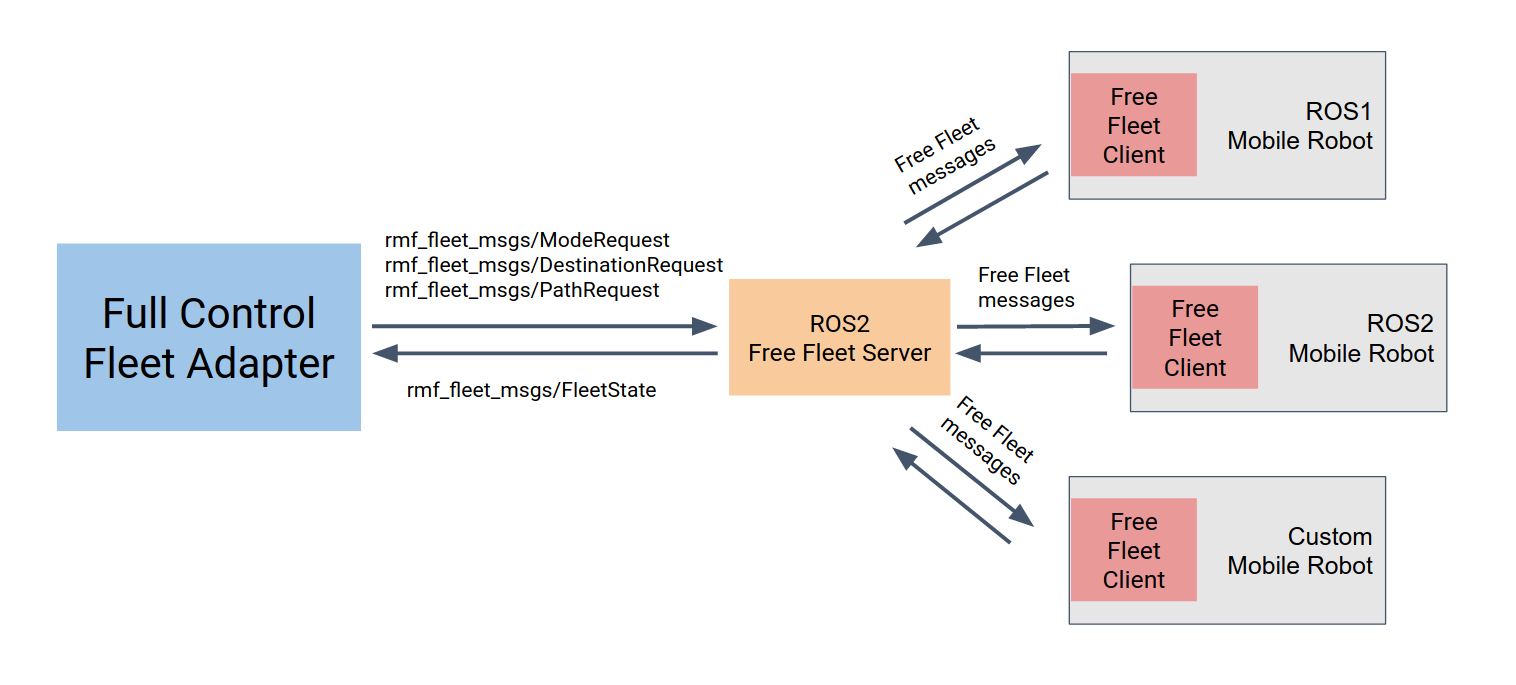Free Fleet
如果用户希望集成不带车队管理系统的独立移动机器人,则可以使用开源车队管理系统“free_fleet”。
“free_fleet”系统分为客户端和服务器。客户端将与导航软件一起在每个独立移动机器人上运行,旨在直接控制移动机器人,同时监控其状态并向服务器报告。客户端的基本实现旨在允许与不同配置的移动机器人进行交互,但向同一服务器报告。这样,用户就可以使用“free_fleet”来管理异构机器人车队,每个机器人车队使用不同的 ROS 发行版、ROS 版本、导航软件或板载通信协议。
服务器在中央计算机上运行,整合来自每个客户端的传入状态更新,以便使用 UI 进行可视化,或向上游转发到 RMF。服务器还通过 UI 将来自用户的命令或从 RMF 转发到要执行的客户端。每个服务器可以同时与多个客户端合作,因此它充当车队管理系统的角色。该服务器可以实现并用作自己的车队管理系统,也可以与 RMF 等更大的系统一起工作,从而弥合每个移动机器人的 API 与 RMF 的 API 和接口之间的差距。
free_fleet 服务器和 free_fleet 客户端之间的通信是使用 CycloneDDS 实现的,因此我们不必担心移动机器人或中央计算机是否运行不同版本的 ROS。
在本节中,我们将介绍使用 free_fleet 与 RMF 集成的 4 种不同方法,特别是机器人使用的导航堆栈。每种方法都保持类似的系统架构,如下面的简单框图所示,但根据机器人开发人员使用的导航堆栈的软件选择,有具体的示例。

ROS 1 Navigation Stack
可以在 free_fleet 存储库 中找到与 ROS 1 导航堆栈配合使用的 free_fleet 客户端实现。该实现需要完全定义移动机器人的变换,移动机器人通过 move_base 操作库接受导航命令,并使用 sensor_msgs/BatteryState 消息发布其电池状态。
按照移动机器人 README 上的构建说明操作后,用户可以将客户端作为启动脚本的一部分启动,同时使用 rosparam 定义必要的参数。下面是一个小片段示例,说明如何启动客户端及其参数,
<node name="free_fleet_client_node"
pkg="free_fleet_client_ros1"
type="free_fleet_client_ros1" output="screen">
<!-- These parameters will be used to identify the mobile robots -->
<param name="fleet_name" type="string" value="example_fleet"/>
<param name="robot_name" type="string" value="example_bot"/>
<param name="robot_model" type="string" value="Turtlebot3"/>
<!-- These are the topics required to get battery and level information -->
<param name="battery_state_topic" type="string" value="example_bot/battery_state"/>
<param name="level_name_topic" type="string" value="example_bot/level_name"/>
<!-- These frames will be used to update the mobile robot's location -->
<param name="map_frame" type="string" value="example_bot/map"/>
<param name="robot_frame" type="string" value="example_bot/base_footprint"/>
<!-- The name of the move_base server for actions -->
<param name="move_base_server_name" type="string" value="example_bot/move_base"/>
<!-- These are DDS configurations used between Free Fleet clients and servers -->
<param name="dds_domain" type="int" value="42"/>
<param name="dds_state_topic" type="string" value="robot_state"/>
<param name="dds_mode_request_topic" type="string" value="mode_request"/>
<param name="dds_path_request_topic" type="string" value="path_request"/>
<param name="dds_destination_request_topic" type="string" value="destination_request"/>
<!-- This decides how long the client should wait for a valid transform and action server before failing -->
<param name="wait_timeout" type="double" value="10"/>
<!-- These define the frequency at which the client checks for commands and
publishes the robot state to the server -->
<param name="update_frequency" type="double" value="10.0"/>
<param name="publish_frequency" type="double" value="1.0"/>
<!-- The client will only pass on navigation commands if the destination or first waypoint
of the path is within this distance away, otherwise it will ignore the command -->
<param name="max_dist_to_first_waypoint" type="double" value="10.0"/>
</node>
正在运行的 free_fleet 客户端将通过 ROS 1 与机器人上运行的节点进行通信,同时使用 free_fleet 服务器发布其状态并通过 DDS 订阅请求。
free_fleet 服务器的当前实现是用 ROS 2 实现的,并使用 RMF fleet 适配器的上述 ROS 2 消息和主题接口与 RMF 进行通信。ROS 2 构建说明也可以在同一个存储库中找到。与客户端类似,已经实现了一个简单的 ROS 2 包装器,可以使用 .launch.xml 文件启动它,如下所示:
<node pkg="free_fleet_server_ros2"
exec="free_fleet_server_ros2"
name="free_fleet_server_node"
node-name="free_fleet_server_node"
output="both">
<!-- Fleet name will be used to identify robots -->
<param name="fleet_name" value="example_fleet"/>
<!-- These are the ROS2 topic names that will be used to communicate with RMF -->
<param name="fleet_state_topic" value="fleet_states"/>
<param name="mode_request_topic" value="robot_mode_requests"/>
<param name="path_request_topic" value="robot_path_requests"/>
<param name="destination_request_topic" value="robot_destination_requests"/>
<!-- These are the DDS specific configurations used to communicate with the clients -->
<param name="dds_domain" value="42"/>
<param name="dds_robot_state_topic" value="robot_state"/>
<param name="dds_mode_request_topic" value="mode_request"/>
<param name="dds_path_request_topic" value="path_request"/>
<param name="dds_destination_request_topic" value="destination_request"/>
<!-- This determines the frequency it checks for incoming state and request messages,
as well as how often it publishes its fleet state to RMF -->
<param name="update_state_frequency" value="20.0"/>
<param name="publish_state_frequency" value="2.0"/>
<!-- These transformations are required when the frame of the robot fleet is
different from that of RMF globally. In order to transform a pose from the RMF
frame to the free fleet robot frame, it is first scaled, rotated, then
translated using these parameters -->
<param name="scale" value="0.928"/>
<param name="rotation" value="-0.013"/>
<param name="translation_x" value="-4.117"/>
<param name="translation_y" value="27.26"/>
</node>
此外,在存储库中也可以找到此配置的示例,位于包“ff_examples_ros1”和“ff_exmaples_ros2”下。此示例启动示例模拟来自“ROBOTIS”,它有一个小型模拟世界,其中有 3 个 Turtlebot3 移动机器人,每个机器人都运行自己的 ROS 1 导航堆栈。
成功构建 ROS 1 和 ROS 2 工作区后,可以按照这些说明 启动模拟,其中还包括一个 ROS 2“free_fleet”服务器,发布舰队状态消息并通过 ROS 2 消息和主题接受模式和导航请求。
ROS 2 导航堆栈
使用 ROS 2 实现的机器人与前面描述的 ROS 1 导航堆栈类似。目前,ROS 2 free_fleet 客户端仍在开发中。重构、实现和测试完成后,将更新本节。
存储库中相同的现成 free_fleet 服务器实现将在此场景中工作,因为舰队适配器提供的接口仍然是相同的 ROS 2 消息和主题。
如果在此期间需要,用户可以通过使用包含 DDS 通信基本实现和 API 的 free_fleet 库来实现自己的 free_fleet 客户端。下一节 开发人员导航堆栈 将进一步阐述。
开发人员导航堆栈
在此实现中,假设移动机器人上运行的软件是由机器人开发人员自己(或其直接分包商)编写的,并且开发人员完全了解并可以访问其机器人的内部控制软件、API 和接口。这种级别的理解和访问对于实现您自己的 free_fleet 客户端包装器是必要的。下面的框图说明了此配置:

一旦开发人员的“free_fleet”客户端完全发挥作用,启动本节前面提到的相同的 ROS 2“free_fleet”服务器以通过 ROS 2 消息和主题与舰队适配器协同工作将是一个简单的任务。